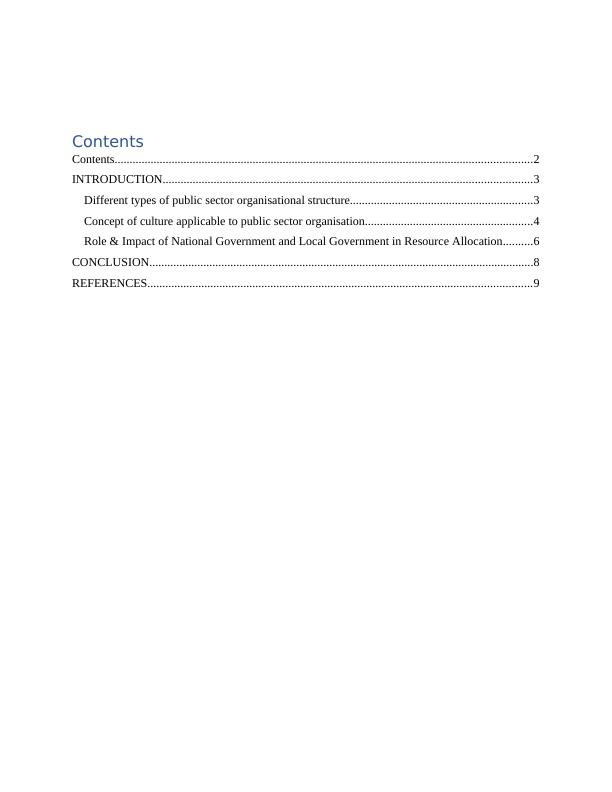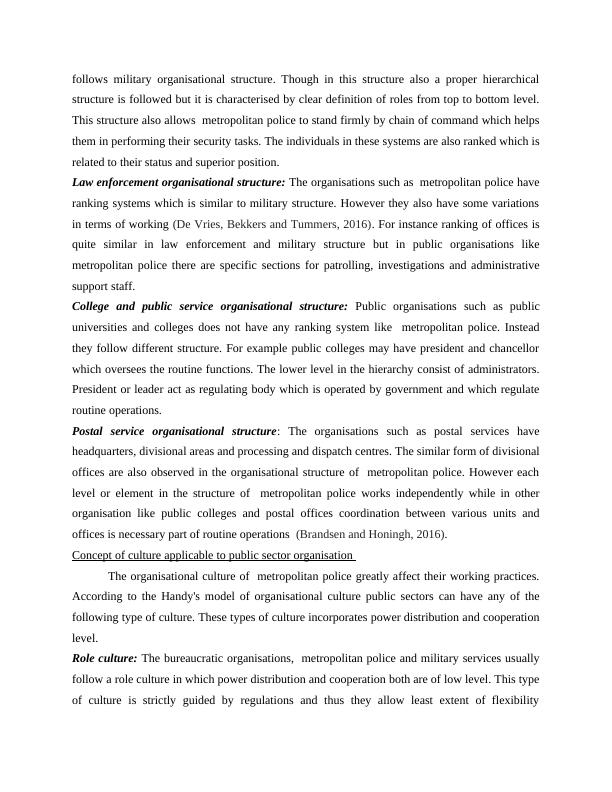Impact of Resource Allocation on London Metropolitan Police
Added on 2023-01-19
11 Pages2878 Words63 Views
How resource allocation impacts the
London Metropolitan Police ( Report )
London Metropolitan Police ( Report )

Contents
Contents...........................................................................................................................................2
INTRODUCTION...........................................................................................................................3
Different types of public sector organisational structure.............................................................3
Concept of culture applicable to public sector organisation........................................................4
Role & Impact of National Government and Local Government in Resource Allocation..........6
CONCLUSION................................................................................................................................8
REFERENCES................................................................................................................................9
Contents...........................................................................................................................................2
INTRODUCTION...........................................................................................................................3
Different types of public sector organisational structure.............................................................3
Concept of culture applicable to public sector organisation........................................................4
Role & Impact of National Government and Local Government in Resource Allocation..........6
CONCLUSION................................................................................................................................8
REFERENCES................................................................................................................................9

INTRODUCTION
Resource allocation is a process of allotment and management of available resources to fulfil
strategic goal of organisation. Resource allocation process includes management of tangible and
intangible resources in order to fulfil their short term and long term goals. London metropolitan
police is known as metropolitan police and MET, Scotland Yard and The Yard. It was formed in
1829 to manage law and order in metropolitan cities like London. This report is providing brief
of different type of structure in public sector organisation. Different type organisational structure
will be studied in order to evaluate best type of organisational culture for public sector
organisation. Role of national and local government will be assessed in order to find their impact
on monitoring and accountability operation. Approaches to management styles will be studied
for Public Sector Company. The organisational behaviour is considered for public sector
organisation to know relationship between motivation and organisational behaviour and it is
evaluated for performance and function of metropolitan police London
Different types of public sector organisational structure
Public sector organisations are known as agencies or companies owned and regulated by
government. Some of the examples of these organisations includes Metropolitan police, state and
city agencies like electricity and oil and gas providers, law enforcement agencies, emergency
services, fire and health care services. As compare to the private organisations, public sector
companies have limited flexibility and their structure and processes are regulated by various
regulations and leaders (Van Dooren and Van de Walle, 2016). Public service organisations
(PSO) such as metropolitan police have different type of organisational structure as compare to
other public service providers. The various types of organisational structure for public services
are as follows:
Divisional structure: In most of the public organisations such as health department and
infrastructure (electricity, oil and gas, water etc.) departments divisional structure is followed. In
this structure organisation is classified into various commissions and departments according to
the type of work they do. For instance in federal government president and employees are in
executive branch while for handling political matters a separate judicial and legislative branch is
there.
Military organisational structure: Contrary to the organisational structure followed by
infrastructural organisations some organisations like navy, military, air and marine forces
Resource allocation is a process of allotment and management of available resources to fulfil
strategic goal of organisation. Resource allocation process includes management of tangible and
intangible resources in order to fulfil their short term and long term goals. London metropolitan
police is known as metropolitan police and MET, Scotland Yard and The Yard. It was formed in
1829 to manage law and order in metropolitan cities like London. This report is providing brief
of different type of structure in public sector organisation. Different type organisational structure
will be studied in order to evaluate best type of organisational culture for public sector
organisation. Role of national and local government will be assessed in order to find their impact
on monitoring and accountability operation. Approaches to management styles will be studied
for Public Sector Company. The organisational behaviour is considered for public sector
organisation to know relationship between motivation and organisational behaviour and it is
evaluated for performance and function of metropolitan police London
Different types of public sector organisational structure
Public sector organisations are known as agencies or companies owned and regulated by
government. Some of the examples of these organisations includes Metropolitan police, state and
city agencies like electricity and oil and gas providers, law enforcement agencies, emergency
services, fire and health care services. As compare to the private organisations, public sector
companies have limited flexibility and their structure and processes are regulated by various
regulations and leaders (Van Dooren and Van de Walle, 2016). Public service organisations
(PSO) such as metropolitan police have different type of organisational structure as compare to
other public service providers. The various types of organisational structure for public services
are as follows:
Divisional structure: In most of the public organisations such as health department and
infrastructure (electricity, oil and gas, water etc.) departments divisional structure is followed. In
this structure organisation is classified into various commissions and departments according to
the type of work they do. For instance in federal government president and employees are in
executive branch while for handling political matters a separate judicial and legislative branch is
there.
Military organisational structure: Contrary to the organisational structure followed by
infrastructural organisations some organisations like navy, military, air and marine forces

follows military organisational structure. Though in this structure also a proper hierarchical
structure is followed but it is characterised by clear definition of roles from top to bottom level.
This structure also allows metropolitan police to stand firmly by chain of command which helps
them in performing their security tasks. The individuals in these systems are also ranked which is
related to their status and superior position.
Law enforcement organisational structure: The organisations such as metropolitan police have
ranking systems which is similar to military structure. However they also have some variations
in terms of working (De Vries, Bekkers and Tummers, 2016). For instance ranking of offices is
quite similar in law enforcement and military structure but in public organisations like
metropolitan police there are specific sections for patrolling, investigations and administrative
support staff.
College and public service organisational structure: Public organisations such as public
universities and colleges does not have any ranking system like metropolitan police. Instead
they follow different structure. For example public colleges may have president and chancellor
which oversees the routine functions. The lower level in the hierarchy consist of administrators.
President or leader act as regulating body which is operated by government and which regulate
routine operations.
Postal service organisational structure: The organisations such as postal services have
headquarters, divisional areas and processing and dispatch centres. The similar form of divisional
offices are also observed in the organisational structure of metropolitan police. However each
level or element in the structure of metropolitan police works independently while in other
organisation like public colleges and postal offices coordination between various units and
offices is necessary part of routine operations (Brandsen and Honingh, 2016).
Concept of culture applicable to public sector organisation
The organisational culture of metropolitan police greatly affect their working practices.
According to the Handy's model of organisational culture public sectors can have any of the
following type of culture. These types of culture incorporates power distribution and cooperation
level.
Role culture: The bureaucratic organisations, metropolitan police and military services usually
follow a role culture in which power distribution and cooperation both are of low level. This type
of culture is strictly guided by regulations and thus they allow least extent of flexibility
structure is followed but it is characterised by clear definition of roles from top to bottom level.
This structure also allows metropolitan police to stand firmly by chain of command which helps
them in performing their security tasks. The individuals in these systems are also ranked which is
related to their status and superior position.
Law enforcement organisational structure: The organisations such as metropolitan police have
ranking systems which is similar to military structure. However they also have some variations
in terms of working (De Vries, Bekkers and Tummers, 2016). For instance ranking of offices is
quite similar in law enforcement and military structure but in public organisations like
metropolitan police there are specific sections for patrolling, investigations and administrative
support staff.
College and public service organisational structure: Public organisations such as public
universities and colleges does not have any ranking system like metropolitan police. Instead
they follow different structure. For example public colleges may have president and chancellor
which oversees the routine functions. The lower level in the hierarchy consist of administrators.
President or leader act as regulating body which is operated by government and which regulate
routine operations.
Postal service organisational structure: The organisations such as postal services have
headquarters, divisional areas and processing and dispatch centres. The similar form of divisional
offices are also observed in the organisational structure of metropolitan police. However each
level or element in the structure of metropolitan police works independently while in other
organisation like public colleges and postal offices coordination between various units and
offices is necessary part of routine operations (Brandsen and Honingh, 2016).
Concept of culture applicable to public sector organisation
The organisational culture of metropolitan police greatly affect their working practices.
According to the Handy's model of organisational culture public sectors can have any of the
following type of culture. These types of culture incorporates power distribution and cooperation
level.
Role culture: The bureaucratic organisations, metropolitan police and military services usually
follow a role culture in which power distribution and cooperation both are of low level. This type
of culture is strictly guided by regulations and thus they allow least extent of flexibility

End of preview
Want to access all the pages? Upload your documents or become a member.
Related Documents
Organisational Structures and Culturelg...
|12
|3895
|40
Metropolitan Police - An Organisational Structure and Culture Interruptionlg...
|7
|1915
|285
Essay on Structure of Metropolitan Policelg...
|7
|2080
|62
Organizational Structure and Culturelg...
|9
|2621
|29
Emergency Management Principleslg...
|10
|3103
|335
Business & Business Environment : Assignmentlg...
|12
|3381
|123
